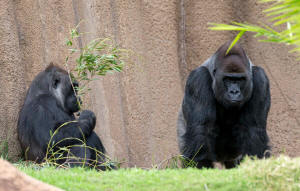|
 Study
finds gorilla origins in half of human AIDS virus lineages Study
finds gorilla origins in half of human AIDS virus lineages
 Send a link to a friend
Send a link to a friend
[March 03, 2015]
By Will Dunham
WASHINGTON (Reuters) - Revealing new
details about the origins of AIDS, scientists said on Monday half the
lineages of the main type of human immunodeficiency virus, HIV-1,
originated in gorillas in Cameroon before infecting people, probably via
bushmeat hunting.
|
|
 HIV-1, which causes AIDS, is composed of four groups, each coming
from a separate cross-species transmission of a simian version of
the virus from apes to humans. HIV-1, which causes AIDS, is composed of four groups, each coming
from a separate cross-species transmission of a simian version of
the virus from apes to humans.
Previous research identified chimpanzees in southern Cameroon as the
source of HIV-1 group M, which has infected more than 40 million
people worldwide and triggered the AIDS pandemic, as well as the
geographically limited group N, identified in only about 20 people.
Until now, the source of the two other groups, known as O and P, had
not been confirmed. The new research, published in the journal
Proceedings of the National Academy of Sciences, showed those groups
originated in western lowland gorillas in southern Cameroon.
"Thus, both chimpanzees and gorillas harbor viruses that are capable
of crossing the species barrier to humans and causing major disease
outbreaks," said virologist Martine Peeters of the Institute for
Research and Development and University of Montpellier in France.

The researchers examined fecal samples from different gorillas
across central Africa, including western lowland gorillas, eastern
lowland gorillas and mountain gorillas in Cameroon, Gabon, the
Democratic Republic of Congo and Uganda, for evidence of the gorilla
version of HIV.
Genetic analyses implicated the western lowland gorillas as the
source of HIV-1 groups O and P.
"The mode of transmission is most likely exposure to infected blood
and/or tissues during hunting and butchering for bushmeat," Peeters
said.
Group O viruses, the second most common HIV-1 lineage, have spread
across Cameroon, Gabon, Nigeria and neighboring countries and have
infected about 100,000 people. Group P viruses have been documented
in just two Cameroonian patients.
[to top of second column] |

The researchers said group O emerged at the beginning of the 20th
century. Group P arose sometime later that century.
University of Pennsylvania microbiologist Beatrice Hahn, the study's
other co-leader, said there does not appear to be any inherent viral
property that prevented the group O lineage from becoming a
pandemic-causing pathogen like group M. "Hence, on this occasion,
humans got lucky," Hahn said.
Another virus type, called HIV-2, is mainly restricted to West
Africa, less easily transmitted than HIV-1 and has a slower
progression to AIDS. It was transmitted from monkeys called sooty
mangabeys to humans in West Africa.
(Reporting by Will Dunham; Editing by Andrea Ricci)
[© 2015 Thomson Reuters. All rights
reserved.] Copyright 2015 Reuters. All rights reserved. This material may not be published,
broadcast, rewritten or redistributed.
 |